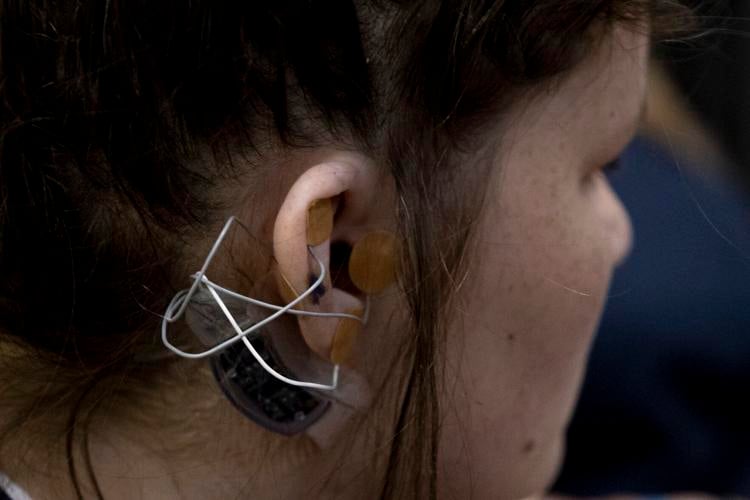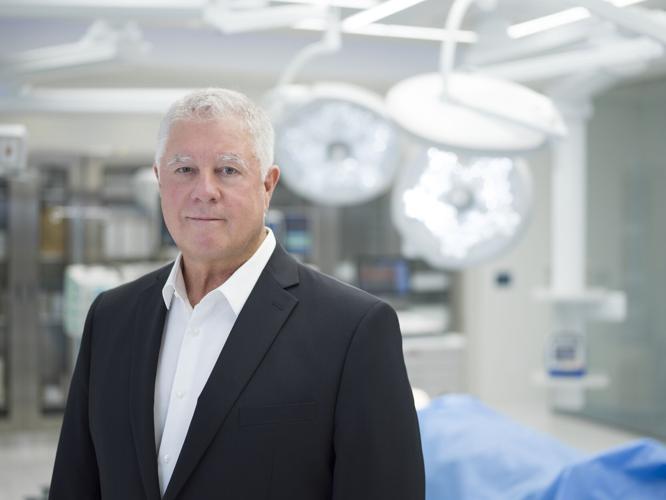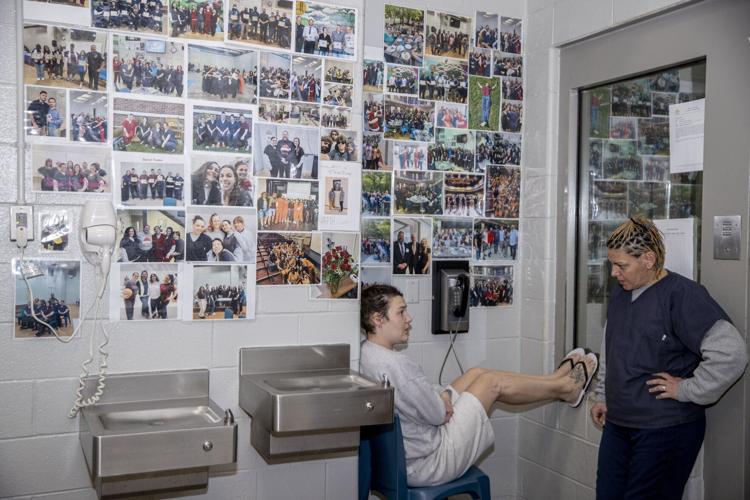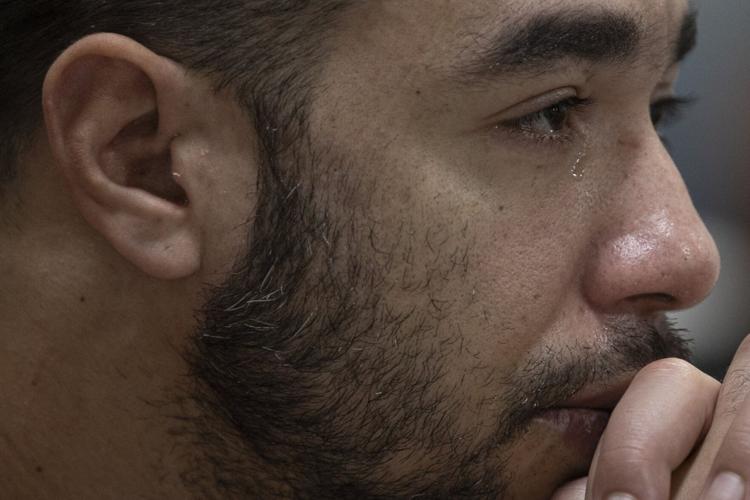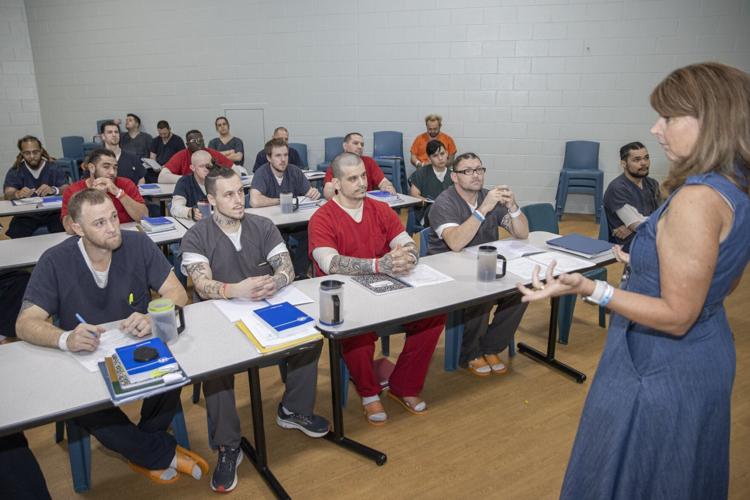At first, Jackie Dameron wasn’t so sure about strapping the electric buzzers to her head.
“Immediately my mind goes to electroshock therapy,” said Dameron, a 29-year-old at the Chesterfield County Jail in Virginia. "I thought I was going to seize and shake or something.”
But she put them on. The alternative was to withdraw from years of opioid and Xanax use on her own, the horror of which she knew from experience.
The county’s jail is the first in the country to debut a new technology said to help addicts through the harrowing pain of withdrawal – a days-long stretch where the body detoxes from a drug or behavior of choice. The device is numbing much of that horror. And, according to the jail’s sheriff, is so attractive that people with active warrants are turning themselves in to receive its benefits.
People are also reading…

When equipped, a Bridge looks like a wired headset, with three points of contact around the ear.
Chesterfield’s new gizmo is known as a Bridge. It works by stimulating nerves in the brain with a gentle, proprietary electric frequency. When equipped, a Bridge looks like a wired headset, with three points of contact around the ear.
“It’s weird having these teeny, tiny things zapping your ears. But the longer I wore it, the better I felt,” Dameron said.
Dameron was wired up last week. A heroin user of 10 years, Dameron said she was introduced to substances by a boyfriend she trusted.
She’s one of 18 to receive the therapy. The jail’s sheriff, Karl Leonard, said they are one shy of a perfect success rate. One effort went awry when the patient wore their electrodes into a shower: a $600 mistake.
So far, the jail is buying the devices with profits from their canteen — a snack shop where inmates can buy jail luxuries like chips or ramen noodles.
Amanda Moore is the latest to wear the Bridge. The electrodes sit snugly around her ear. Under her hair, they are hard to notice.
Moore came into the jail in late May, where she began detoxing from 12 years of on-and-off use of heroin and methamphetamines.
“It’s definitely helping,” said Moore. “Usually if I was detoxing I’d be in my bed. I’d be tossing and turning, miserable, not able to sit up straight and participate. It really does work.”
Sheriff Karl Leonard shared that Moore had taken off her Bridge device on Saturday, then died of unknown causes on Sunday. There is no reason to believe that the death was connected to the device, for which medical examiners say the cause and manner are still pending.
Altering the feedback loop
It’s the target response for the device’s creators in California. The company, Masimo, launched Bridge in 2020. It’s the first of its kind to be approved by the FDA for treating opioid withdrawal, which can last up to two weeks.
Withdrawals occur when a brain accustomed to a dopamine-releasing chemical of choice is suddenly cut off. The absence of alcohol, cocaine, heroin and even certain addictive behaviors tilts the brain's chemical seesaw into a deprivation state.

Dr. William Wilson, EVP of Clinical Research and Medical Affairs for Masimo. Masimo's new technology, the Bridge, is being used to help addicts at Chesterfield's County Jail.
The brain’s pleasure center, where this drama unfolds, basically goes haywire, said Dr. William Wilson, head of clinical research for Masimo.
“One way or another you need to alter the feedback loops that are causing malfunction of the brain,” said Wilson. “And here you're stimulating certain loops that are decreasing the pain, the anxiety, the discomfort and the ill-feeling associated with opioid withdrawal.”
The company is pushing for more insurers, including Medicaid, to cover the $600 device. Masimo spokesperson Irene Mulonni said patients currently pay for the device out of pocket. Each Bridge runs for five days before its battery dies. The device is not reusable.
For years, addicts have weathered the storm of withdrawal through medication — from extra strength Tylenol to clinically supervised methadone treatments. Wilson said the company wanted to make something to help addicts that didn’t involve a pill.
“This is really the start,” said Wilson. “And it’s also what the future looks like.”
Untraditional corrections
This month, a man emailed Leonard with an unusual request after watching a news segment regarding the Bridge device.
“I wanted to reach out to you in reference to turning myself in,” said the man, whose name the sheriff asked be withheld. "I’m ready to throw in the towel as it stands right now … I’m beat and tired and need help bad.”
Leonard’s jail may be one of the few in the country where wanted criminals surrender themselves freely — and where alumni come back willingly.
For years Leonard’s jail has offered a program called HARP — Helping Addicts Recover Progressively. It’s composed of two separate areas in the jail where men and women commit to recovery.
In a circle similar to one that might be formed by a 12-step group, women in the HARP program talked about the Bridge, their pathways to addiction, and the tools they’ve found to fight their worst cravings.
Some, like Jamie Boggs, are HARP alumni who have already been released, but have returned as part of their recovery. In a jail pod full of jumpsuits, Boggs stands out in her street clothes.

Inmates with substance use disorder spend time in recovery at the Chesterfield County Jail on May. The jail introduced a technological device to its inmates called the Bridge, which helps them through withdrawals from opioids, which can be horrific and painful.
The program is run by Kerri Rhodes, a licensed counselor whose son Taylor died of an opioid overdose in 2019. Her mission is personal.
And she loves to push her clients outside of their comfort zone.
“That’s part of HARP. We love to make them uncomfortable every chance we get. Because if they can deal with uncomfortable, that’s a real step in the right direction for your recovery,” said Rhodes.
Harp isn’t “traditional corrections,” Rhodes said. Megan Thurston, a HARP participant, called her time her “the best experience I’ve ever had.”
“In a jail,” Thurston quickly added, with a laugh.
'It's not magic'
Jennifer Hughes, one of the women in the HARP pod, described her own withdrawal as a “river of misery.”
“These people see that we’re suffering. We’re not just a number,” said Hughes, who will be released in December. “And they let us know that on a daily basis.”
In that light, the Bridge is just another addition to an arsenal of ideas that Rhodes has introduced.

A member in recovery sheds a tear as he watches a documentary on substance use addiction at the Chesterfield County Jail. The county’s jail is the first in the country to debut a new technology said to help addicts through the harrowing pain of withdrawal.
“The Bridge is a tool. It’s not magic, it’s not a wand. It didn’t take it all away," said Rhodes.
But maybe its magic is in making it just a little bit easier to ask for help. Rhodes asks the circle if any of the women would have turned themselves in willingly while they were using.
None of the women reply.
“How many of you would have turned yourselves in if you knew there was a way to manage withdrawal and for us to help you?” Rhodes asked.
Every woman in the circle raised their hand.

Inmates with substance use disorder spend time in recovery in the Chesterfield County Jail in May.
25 most commonly used recreational drugs in America
America's vices: Alcohol, tobacco and more
From alcohol to cigarettes, most adults have tried some form of recreational drug. Fewer people have experimented with prescription medication for recreational reasons, but certain areas of the country are experiencing a serious problem with opoid addiction. Other drugs like cocaine and LSD, are used sporadically among adults in the U.S.
Using data from the Substance Abuse and Mental Health Data Archive, the experts at HealthGrove, a health data site, ranked the 25 most commonly used recreational drugs. The substances are ordered by the increasing percentage of people age 12 and over who used the drug recreationally in 2015. In the case of a tie, the drug with a higher classification by the Drug Enforcement Administration (DEA) is ranked higher.
To collect this data, SAMHDA conducts the annual National Survey on Drug Use and Health, in which they record use of illicit drugs, alcohol and tobacco in the U.S. population aged 12 or older. It is important to note that this data only includes recreational use of drugs, not proper medical use.
Drugs that are legal, alcohol and tobacco, have the highest recreational use. According to the survey, nearly one in five people over the age of 12 also used marijuana in 2015. As the drug becomes legal in more states, recreational use is likely to increase. Other Schedule I drugs (drugs determined to have no medical benefit by the DEA) including heroin and DMT had a recreational prevalence rate of less than 1 percent in 2015.
Note: Not all images in slideshow depict the exact drugs.
#25. Ketamine
#24. Oxymorphone
#23. DMT
Recreational use prevalence (2015): 0.2 percent
Drug category: Hallucinogen
DEA Schedule: I
Common forms: Powder, crystal
#22. Carisoprodol (Soma)
#21. Methadone
#20. Lorazepam (Ativan)
#19. Morphine
#18. Buprenorphine
Recreational use prevalence (2015): 0.38 percent
Drug category: Opioid
DEA Schedule: III
Common forms: Pill
#17. Heroin
#16. Zolpidem (Ambien)
Recreational use prevalence (2015): 0.45 percent
Drug category: Sedative
DEA Schedule: IV
Common forms: Pill, capsule, liquid
#15. Diazepam (Valium)
Recreational use prevalence (2015): 0.54 percent
Drug category: Tranquilzer
DEA Schedule: IV
Common forms: Pill, capsule, liquid
#14. Clonazepam (Klonopin)
Recreational use prevalence (2015): 0.6 percent
Drug category: Tranquilzer
DEA Schedule: IV
Common forms: Pill
#13. Methylphenidate (Ritalin)
#12. Methamphetamine
#11. Tramadol
#10. LSD
#9. MDMA (Ecstasy/Molly)
Recreational use prevalence (2015): 1.5 percent
Drug category: Hallucinogen
DEA Schedule: I
Common forms: Tablet, capsule, liquid
#8. Alprazolam (Xanax)
#7. Oxycodone (OxyContin)
Recreational use prevalence (2015): 2.05 percent
Drug category: Opioid
DEA Schedule: II
Common forms: Capsule, liquid, tablet


